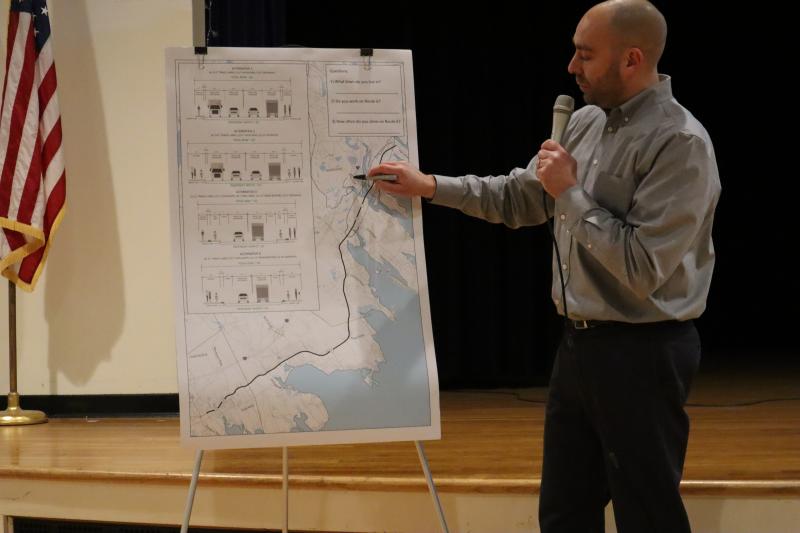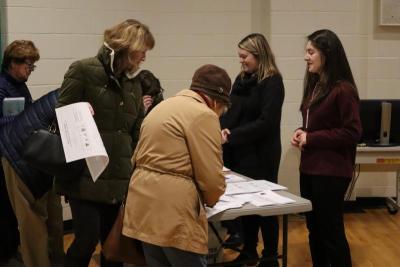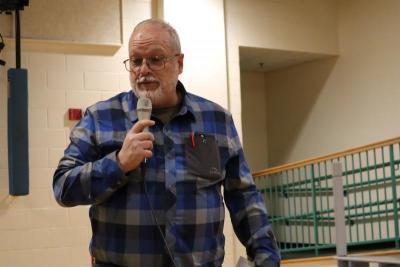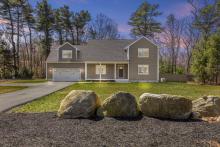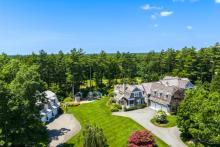Route 6 may see changes in the future
MARION — Jed Cornock, of the Southeastern Regional Planning and Economic Development District (SRPEDD), presented a series of possible upgrades for Route 6, and fielded questions from the community during an informational meeting at Sippican School on Monday, Jan. 6.
The section of Route 6 being considered is about 13 miles long and stretches from Route 240 in Fairhaven to High Street in Wareham. In his presentation, Cornock said that 10,000 to 15,000 vehicles travel this section of Route 6 each day, most at speeds between 45 and 50 miles per hour.
Based on observations made by SRPEDD, and previous feedback from the community, aspects of Rte. 6 in need of improvement include the inconsistent sidewalk conditions throughout Route 6, and narrow travel lanes and shoulder spaces.
To improve conditions, Cornock presented four main alternatives to the current setup of the road.
The first alternative would consist of four 10 ½-foot travel lanes with two 6-inch shoulders, and a six-foot wide sidewalk on each side of the road. This option would create a consistent sidewalk throughout the section of Route 6, but would not improve conditions for cyclists on the road.
The second alternative would also have four 10 ½-foot travel lanes with two 6-inch shoulders, but would also include an elevated 10-foot sidepath for bicyclists and pedestrians.
One person in attendance asked if this option could mean that residents may lose space on their property to accommodate the wider right of way, to which Cornock responded that it might.
The third alternative would consist of two 11-foot travel lanes, two five-foot shoulders, two five-foot bike lanes, two 1.5-foot grass buffers, and two five-foot sidewalks. While this plan would create separate facilities for bikes and pedestrians, vehicle passing opportunities would be limited, utility poles would likely need to be moved, and drainage systems would likely need to be modified.
The fourth alternative would be the same as the third, but cyclists would share the sidewalk with pedestrians.
The option to limit Route 6 to two travel lanes received both positive and negative feedback from those in attendance.
Those against the idea said the road would become more congested with just two lanes. Some mentioned that the plan doesn’t take into consideration the “seasonality” of communities like Marion where the population is larger in the summer. It may also make it more difficult for vehicles pulling boats on trailers, another factor specific to the area.
Others cited a time in the 1980s when Route 6 was limited to two lanes, and accident rates increased, although SRPEDD’s designs are different from those in the past.
Robert Price, of Mattapoisett, spoke in favor of the two-lane option. As a cyclist, Price said he often feels unsafe on Route 6 due to the speed of the cars, and how close cars come to him while driving down the road. Price said that the two-lane option could make the road safer and more appealing to cyclists, and that Interstate 195 is available for those who want to drive faster.
In addition to these possible alternatives, Cornock mentioned some specific areas that would require special attention. One such location was the intersection at Converse Road in Marion.
Currently this intersection includes a triangle shaped island, which Cornock suggested removing to improve safety conditions. When asked about how this would make the intersection safer, he said that there are currently three points where vehicles can come into contact with each other. If the intersection met at a standard 90 degree angle, there would only be one such point. Cornock admitted that the flow of traffic may slow down if this change is made.
Other intersections with odd angles that can potentially cause safety issues include Spring Street, and Church Street Extension in Marion, as well as Swifts Beach Road in Wareham.
Since December, 2018, three pedestrians have been struck at the Swifts Beach Road intersection. SRPEDD gave this intersection the lowest possible grade, based on high levels of driver frustration and excessive delays.
One possible improvement for Swifts Beach Road would be to transition from a stop sign to a signal light. SRPEDD’s projections predict that drivers would face less delays at the intersection, if the signal light were put in place.
At the end of the informational meeting, attendees were asked to fill out a form to submit feedback on the project, and possible alternatives.
Cornock stressed that possible upgrades are still in the planning phase, and SRPEDD will not directly conduct the engineering for renovations, once they begin.
To learn more, go to www.srpedd.org/Route-6-Corridor-Study. The planner will accept feedback in survey form through January 20. To fill out a survey, visit https://www.marionma.gov/sites/marionma/files/uploads/route-6-cs-alternatives-preference-survey.pdf.



